|
Related FAQs: Sea Stars 1, Sea
Stars 2, Sea Stars 3, Sea Stars 4, Sea
Stars 5, Brittle Stars,
Seastar ID 1, Seastar ID 2, Seastar ID 5, Seastar ID 6 & Seastar Selection, Seastar Compatibility, Seastar Behavior, Seastar Systems, Seastar Feeding, Seastar Reproduction, Seastar Disease, Seastar Disease 2, Seastar Disease 3,
Star Disease 4, Star
Disease 5, & Asterina Stars, Chocolate Chip Stars, Crown of Thorns Stars, Fromia Stars, Linckia Stars, Linckia Stars 2, Sand-Sifting
Stars,
Related Articles:
Echinoderms, An Introduction to the
Echinoderms: The Sea Stars, Sea Urchins, Sea Cucumbers and
More... By James W. Fatherree, M.Sc. Brittle
Stars, Asterina Stars,
Crown of Thorns Seastars,
Marine
Scavengers,
Sea Stars, Class Asteroidea
part 6 of 11
To:
Part
1, Part 2, Part 3, Part
4, Part 5,
Part 7, Part 8,
Part 9, Part 10,
Part 11
|
|
|
By Bob Fenner
|
|
Not So Spiffy Choices, But Often Seen:
Much less desirable, but commonly offered and attractive are
the "knobbed" Sea Stars, Family Oreasteridae of the genera
Protoreastor, Pentaster and Pentaceastor. They are
distinguished by having dull spines, bumps or knobbles on their dorsal
surfaces, with these often seen in colors that contrast with their
overall body pigmentation. Sold under names like Red-Knobbed, Chocolate
Chip, and other labels, these species are hardy but aggressive feeders,
more than happy to mount and consume sessile clams, oysters and all
manner of corals, soft and stony.
| Protoreastor lincki African or Horned Sea
Star An opportunistic omnivore of other invertebrates that can
literally clean sweep an aquarium of sedentary life. Aq. pic. |

|
Bigger PIX:
The images in this table are linked
to large (desktop size) copies. Click on "framed" images
to go to the larger size. |
|
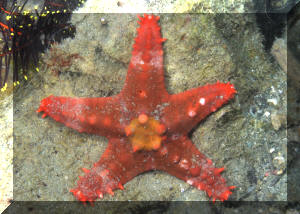
|
| Another "Knobby" species, the Chocolate
Chip Star, Protoreastor nodosus at a wholesalers and close
up in N. Sulawesi. An opportunistic omnivore on other
invertebrates. Found widely throughout the tropical Indo-Pacific.
Select for smaller 2-3 inch specimens and keep them well fed; though rarely
lives for long in captivity. |
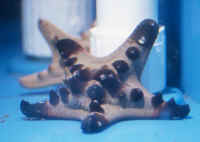 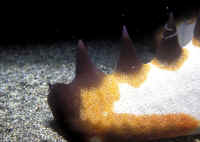
|
Bigger PIX:
The images in this table are linked to large (desktop size) copies.
Click on "framed" images to go to the larger size. |
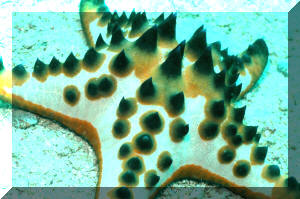
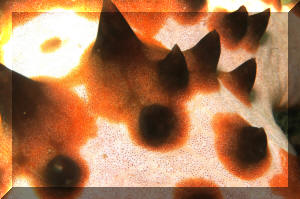
%20MD.JPG) |
Family Oreastridae: "Plump" stars. Have large,
domed discs with short or no arms at all. Not easily kept... i.e.
rarely live in captivity.
| Another typical offering, the "Doughboy"
Sea Star, Choriaster granulatus, Lutken 1869, is a big,
bulky Indo-Pacific asteroid that scavenges in reef shallows. It
should only be employed in systems of hundreds of gallons size with
corals that can be spared... as it is a coral eater. |
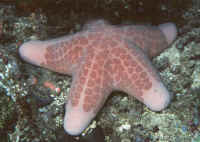
|
| Another typical offering, the "Doughboy" Sea Star,
Choriaster granulatus, Lutken 1869, is a big, bulky Indo-Pacific
asteroid that scavenges in reef shallows. It should only be employed in
systems of hundreds of gallons size with corals that can be spared... as it
is a coral eater. |

|
To:
Part
1, Part 2, Part 3, Part
4, Part 5,
Part 7, Part 8,
Part 9, Part 10,
Part 11
|
|

